#moebius strip ii
Explore tagged Tumblr posts
Text
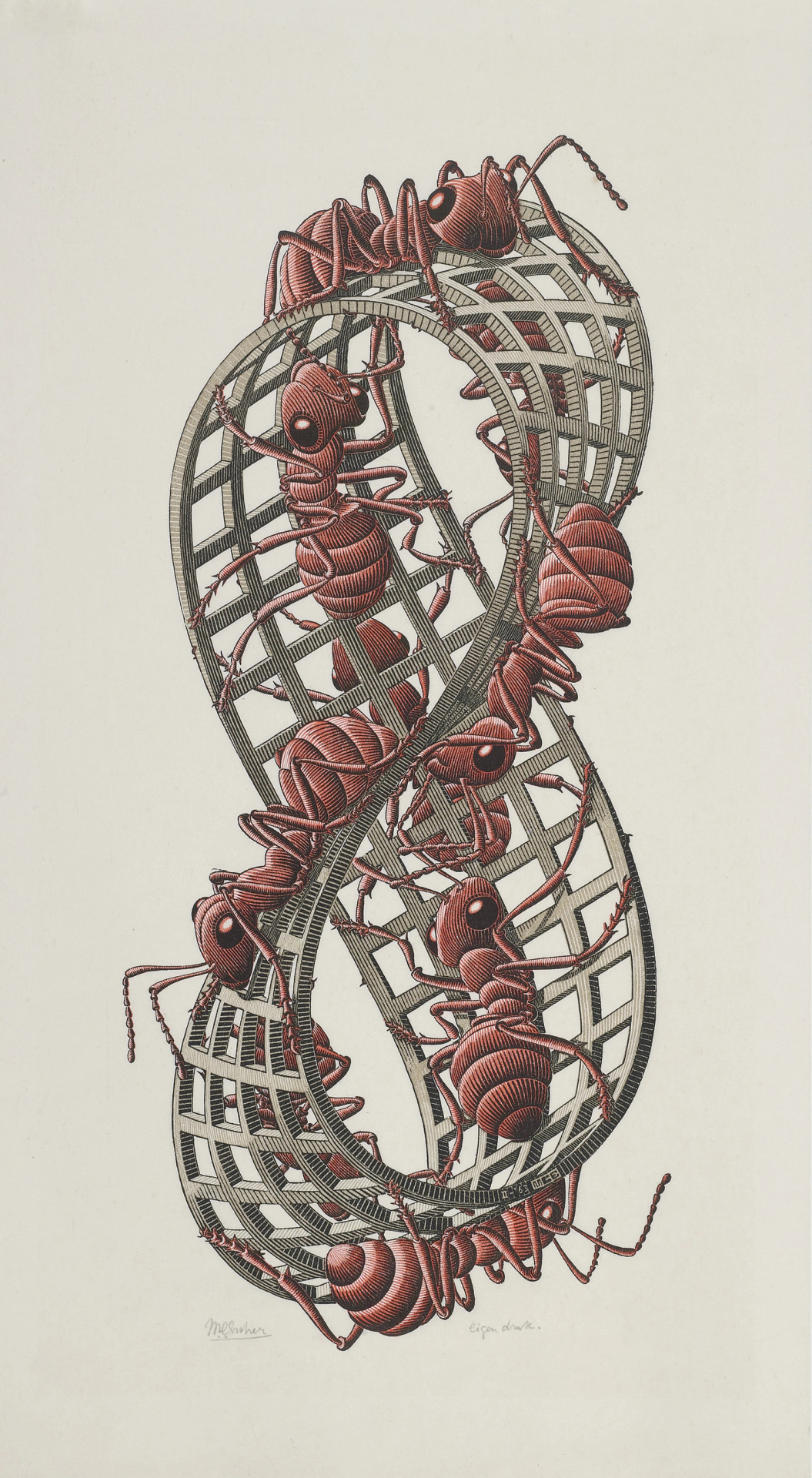
source: bishopsbox
Moebius strip II (1963), woodcut in red, black and gray-green, printed from three blocks
by: M.C. Escher
24 notes
·
View notes
Text

Moebius Strip II, 1964, M.C. Escher
147 notes
·
View notes
Photo

MWW Artwork of the Day (7/8/18) M.C. Escher (Dutch, 1898-1972) Moebius Strip II [Red Ants](Feb. 1963) Woodcut in brown, black & gray-green, 45.3 x 20.5 cm.
The Möbius strip, with its "half-turn", has remarkable mathematical properties. It can be cut down the middle without falling apart into two rings, and it has only one side and one edge. Escher noted, "An endless ring-shaped band usually has two distinct surfaces, one inside and one outside. Yet on this strip nine red ants crawl after each other and travel the front side as well as the reverse side. Therefore the strip has only one surface".
Check out these two MWW Escher galleries which between them contain almost all of his work: * M.C. Escher -- The Early Years (1917-37) * The Topsy-Turvy World of M.C. Escher (1938-1972)
8 notes
·
View notes
Photo
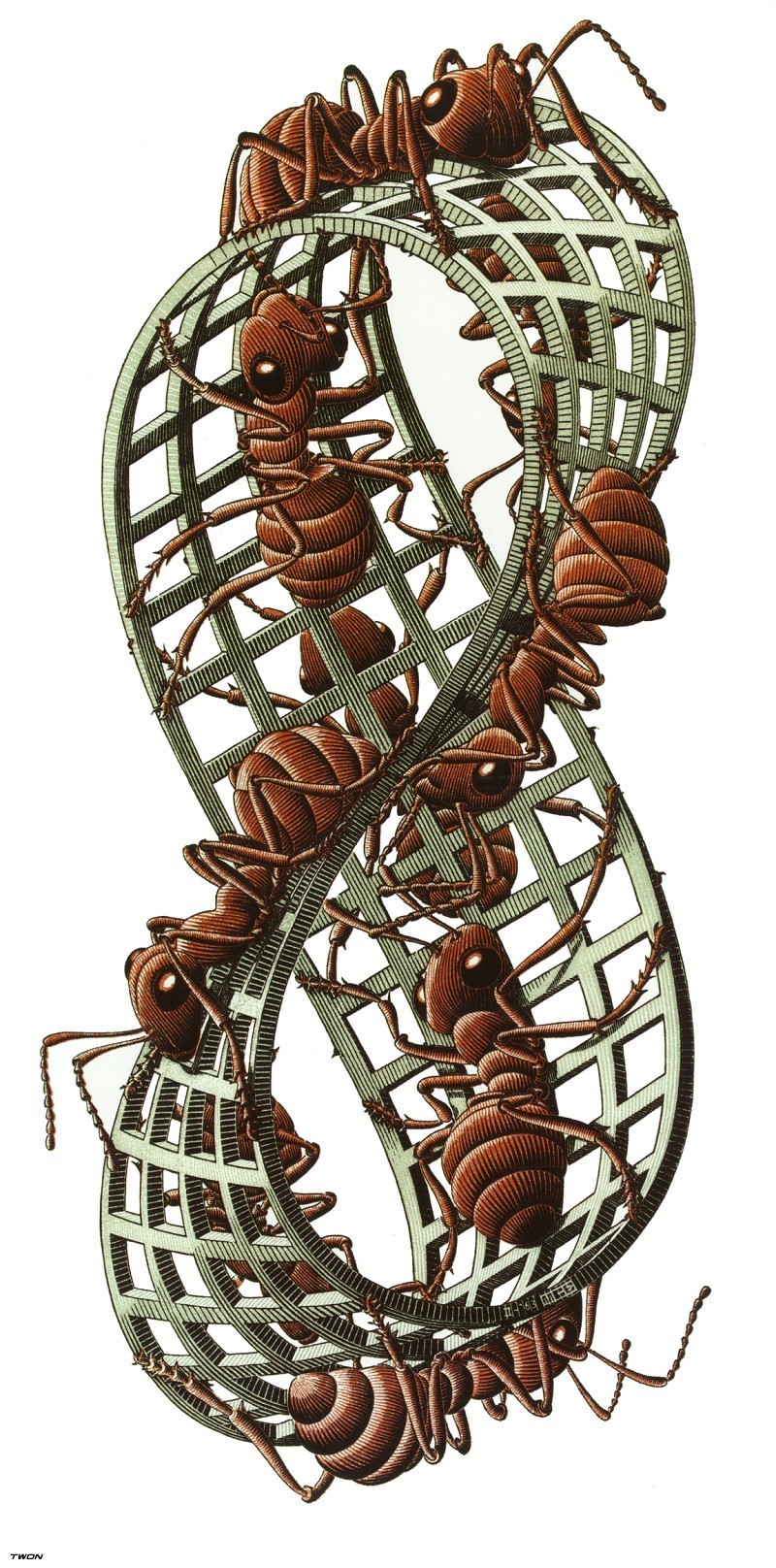
Moebius Strip II, 1964, M.C. Escher
475 notes
·
View notes
Photo

WANT IS A SELF-FULFILLING PROPHECY, BUILT TO TRIP OVER ITS OWN FEET. I AM ALWAYS DROWNING IN ITS HUNGER.
In the lead up to our next event, we will be having a development week where characters that may not have interacted yet will be paired up together to build deeper connections. For this week, you will each be required to reach out to two other characters, explore these dynamics in the past and/or present, and write threads together on Tumblr or Discord. The threads can be set in the present day, or as a flashback.
While the threads do not have to be finished by the end of this week and can be continued into the next event, please make a start on them before Saturday, February 26th.
You are welcome to create your own dynamic or use one of the following for inspiration:
I. SALVATION: A moment of vulnerability, where one character showed compassion to another or helped them in some way.
II. HUNGER: Everyone hungers for something — desire, ambition, power, belonging, love. A moment of hunger that brought your characters together.
III. DAMNATION: A moment of conflict, where one character clashed with another, where a betrayal / deceit / argument splintered them.
The pairings for the characters are as follows:
NAZRIN x SÉVERINE
CARINA x AUGUST
AUGUST x NAZRIN
DANTE x HADRIAN
SOUNDARYA x SUTTON
VERITY x AMIRAH
HADRIAN x NAZRIN
GENEVIÈVE x BELLAMY
AMIRAH x NIKHIL
BELLAMY x CARINA
SUTTON x SAINT
NIKHIL x HECTOR
SAINT x GENEVIÈVE
SÉVERINE x DANTE
VERITY x SOUNDARYA
Below the cut are some quotes you can use for additional inspiration!
I. “To vow yourself to someone else is to open a wound. From it blood flows freely, life of you to them.” — Jeanette Winterson, Gut Symmetries
II. “You can have my heart if you have the stomach to take it.” — Yves Olade, Bloodsport
III. “The monster. The dreamer, the eater. The eater monster. You the monster, I the monster. All of us the monster. The monster in us, the monster in you. The monster in all of us.” — Mahtem Shiferraw, Fuschia
IV. “Rage is gripped in the hands. Rage gets stuck in the throat, suppressed. Rage is a promise kept.” — Sjohnna McCray, Rapture
V. “What lived and died between us—haunts me still.” — Lidia Yuknavitch, The Chronology of Water: A Memoir
VI. “I will soothe you and heal you. I will bring you roses. I too have been covered with thorns.” — Rumi, Bittersweet
VII. “Dig your teeth into me. Come on, I dare you. Take a bite. Open me up.” — Ashe Vernon, It’s a circus and we all paid to be here
VIII. “Was it lust or hunger? How could I tell the difference?” — Margaret Atwood, Stone Mattress: Nine Wicked Tales
IX. “A moebius strip, a snake swallowing its own tail. Mutually assured destruction, maybe, or mutual deification. Mutual consumption.” — Becca De La Rosa and Mabel Martin, Mabel
X. “Sometimes, you just want / something so hard you have to lie about it, / so you can hold it in your mouth for a minute, / how real hunger has a real taste.” — Ada Limón, Bright Dead Things
XI. “That we are always alone in pain is a lie, I think: that language fails it, another.” — Anne Boyer, The Undying: A Meditation on Modern Illness
XII. “What is more basic than the need to be known? It is the entirety of intimacy, the elixir of love, this knowing.” — Audrey Niffenegger, Her Fearful Symmetry
XIII. “We can make do with so little, just the hint of warmth, the slanted light.” — Molly FIsk, Winter Sun
XIV. “He and I are closer than friends. We are enemies linked together. The same sin binds us.” — Oscar Wilde, An Ideal Husband
XV. “I always knew that you would hurt me to death some day, but I hoped to choose the time and place.” — Rebecca West
XVI. “You horrify me. But at the same time, I horrify myself. We are horrible.” — Hélène Cixous, The Perjured City
XVII. “There’s something soft in me / we killed it and it’s rotting.” — Cassandra de Alba, A Barbie Dream House But All the Dolls Are Kitchen Knives
XVIII. “We make each other alive. Does it matter if it hurts?” — Ingmar Bergman
XIX. “Do you see now? My tongue, the dagger at your jugular. My love, the sword at your bosom. Which do you want?” — Venetta Octavia, I Set It in Stone
XX. “He, like me, is haunted by his heart.” — Mahmoud Darwish, Tuesday and the Weather is Clear; If I Were Another: Selected Poems
4 notes
·
View notes
Text
Inverted Mobius, Mr. Tesseract and The Avatar of Truth
The mystery of the weird collar has deepened, thanks to @nebulousfishgills - by which I mean they totally solved it.
To those just joining me, I noticed this in my previous breakdown of the Loki trailer here.
Mr. Mobius, played by Owen Wilson, has an ‘inverted suit’. His collar is an indentation in his suit, rather than going on top of it.

So, first, a scene from Endgame that I seriously did think of when we learned there was a character called ‘Mobius M. Mobius’ in Loki (played by Owen Wilson). And yet I didn’t put this together. Thanks again to nebulousfish for making me realize that these things might not be coincidences.
When Mr. Stark is inventing time travel, he asks his AI to create a depiction of a Mobius Strip, inverted.

Which gets him this:

Anyway, what is a Mobius Strip, and who is Mobius M. Mobius? (Not to be confused with Morbius the Living Vampire, though wouldn’t it be funny if he was mistaken for Mobius M. if this show gets big first?)
I am not a quantum theorist or comic book aficionado by trade, so let’s do a Wikipedia-Fu on it.

In mathematics, a Möbius strip, band, or loop (US: /ˈmoʊbiəs, ˈmeɪ-/ MOH-bee-əs, MAY-, UK: /ˈmɜːbiəs/;[1]German: [ˈmøːbi̯ʊs]), also spelled Mobius or Moebius, is a surface with only one side (when embedded in three-dimensional Euclidean space) and only one boundary curve. The Möbius strip is the simplest non-orientable surface.
An example of a Möbius strip can be created by taking a strip of paper and giving one end a half-twist, then joining the ends to form a loop; its boundary is a simple closed curve which can be traced by a single unknotted string. Any topological space homeomorphic to this example is also called a Möbius strip, allowing for a very wide variety of geometric realizations as surfaces with a definite size and shape. For example, any rectangle can be glued left-edge to right-edge with a reversal of orientation. Some, but not all, of these can be smoothly modeled as surfaces in Euclidean space. A closely related, but not homeomorphic, surface is the complete open Möbius band, a boundaryless surface in which the width of the strip is extended infinitely to become a Euclidean line.A half-twist clockwise gives an embedding of the Möbius strip which cannot be moved or stretched to give the half-twist counterclockwise; thus, a Möbius strip embedded in Euclidean space is a chiral object with right- or left-handedness. The Möbius strip can also be embedded by twisting the strip any odd number of times, or by knotting and twisting the strip before joining its ends.
A Möbius strip does not self-intersect but its projection in 2 dimensions does.
Uh....right. Well, that clears everything up, doesn’t it?
Let’s crib off someone else’s work. Thanks to Thomas Wong on Medium, I was able to understand this a little better.
A Möbius strip is just a strip of paper, turned and taped together. It it only has one side, so an ant walking along the strip eventually returns to where he started. If we metaphorically interpret the ant, not as returning to a point in space, but a point in time, then it alludes to time travel.
...
As previously discussed, after a measurement, the quantum mixture (half born and half never born) becomes a definite state (born or never born). Finding the “spectral decomposition” is to find all the possible energies (eigenvalues) and states. Using these, one can determine how a quantum object evolves with time.
Combining this with the metaphoric interpretation of the Möbius strip, it could be that Stark found how to make quantum objects evolve such that they revisit a point in time, hence time travel.
Okay, that’s a little easier to understand. So how does this relate to the character Mobius M. Mobius, aside from him being named after the strip and the (apparently antiquated) ideas about time travel?
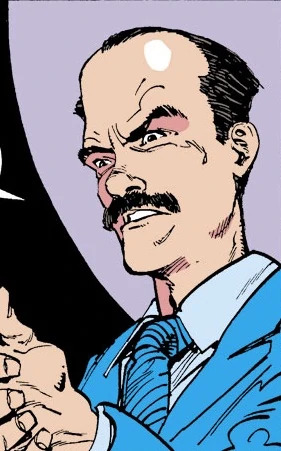
Well, he was based on Marvel Comics Legend Mark Gruenwald, a guy known for his passion for the lore of the comics, which he knew in innate detail. He even wrote the Official Handbooks and whatnot. Likewise, Mr. Mobius is a stickler for detail and one of the few members of the TVA even allowed a face - although it is off the rack, as he’s one an infinite number of clones (god I love the TVA so much already, it’s heaven for a Douglas Addams fan like me).
Despite being a clone, he rose through the ranks and is nearly the top guy, serving only underneath Mr. Alternity (and I am not familiar with these comics so feel free to correct me). Mr. Alternity has almost no comics history, but is based on editor Tom Brevoort.
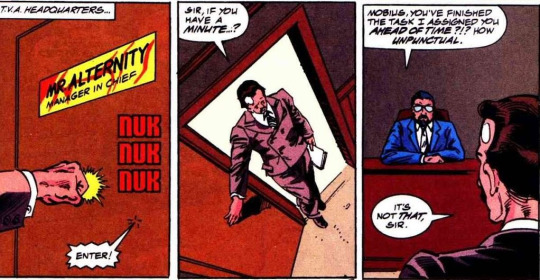
There are several other misters, all of them near-identical to ‘Moby’. Mr. Orobourous, Mr. Paradox, Mr. Tesseract (!) and Mr. Oburos. They are also minor characters, but let’s look at all these names.
Clearly they are named after quantum theories of some-sort or another.
Mr. Mobius: Mobius Strip Theory - the idea that, essentially, is about the shape of time itself and the theory of traveling along that shape.
Mr. Alternity : Alternative universes
Mr. Ouroboros: A divine figure representing the beginning and the end of time in an endless cycle of death and rebirth.
Mr. Oburos - I’m not sure, but I think this is a variant of Ouroboros.
Mr. Paradox - Temporal paradox, causal loops - ex. The Grandfather Paradox
Mr. Tesseract - An object that exists in 4 dimensions. Time is often called the fourth dimension.
Obviously that last one is interesting, considering how the Tesseract will be the start of our adventure. The Cosmic Cube was renamed for the MCU, and in the comics has no relation to this minor character.
But what if it now does?
What if Tony has caused a change in the very appearance of Mr. Mobius when he inverted the Mobius Strip - literally inverting his clothing because he changed the shape of the Mobius - does that mean that these seemingly human-looking misters are in fact some sort of avatars for aspects of time itself? And if Mr. Tesseract is representative of how space and time intersect in the fourth dimension, wouldn’t a rogue god twisting space and time with the device that shares his name cause him some affect? Perhaps why the TVA noticed something was amiss to begin with.
This would be a departure from the comics, but the characters have almost no history there. They are ripe for new ideas.
Or, then again, since Loki will be working for the TVA - perhaps he’s the one who becomes ‘Mr. Tesseract’?
But continuing with that ‘Avatar of Aspects’ idea, let’s get away from this sausagefest for a second and visit my next newest favourite character -
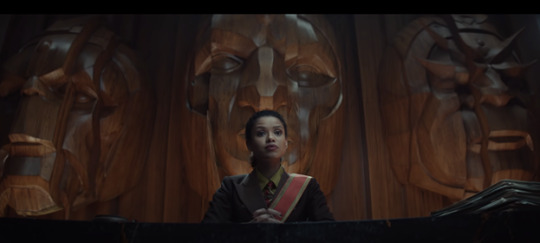
I’m guessing she’s one of the Justices of the TVA. What gives it away? The imperious look, the giant oaken table, or the fact that I’m suddenly self-conscious when she looks at me? It’s the last one, of course. She’s a natural judge.
Of the named TVA judges, there’s :
Justice Goodwill, Justice Hope, Justice Liberty, Justice Love, Justice Might, Justice Mills, Justice Peace and Justice Truth.
Could they also possibly be avatars of their respective aspects?
If I had to guess, I’d say this is Justice Truth, as pairing up Loki with an avatar of Truth seems like it’d be a smashing good time, similar to how he was paired with Verity Willis in the comics. She might even be a composite character with Verity.
Verity’s power is detecting and seeing through all lies and illusions. I think this powerset will be given to Justice Truth, except instead of deriving it from a magic ring that she swallowed, she’d simply be the actual ‘Embodiment of Truth’ - and let’s get real here, when I said ‘Avatars of Aspects’, I was using that clunky phrase because the more obvious one - God of - is already ‘taken’. So Justice Truth may well be the ‘God of Truth’, as it were.
I think she’ll end up in something of a buddy-comedy with Loki, giving him someone to bounce off against who literally cuts through his carefully crafted veneer.
I’m reminded of a great quote from Taika Waititi when he was talking about what he wanted to do with Loki in Ragnarok:
“(He’s) someone who tries so hard to embody this idea of the tortured artist, this tortured, gothy orphan...It’s too tiring trying to be like that,” he says. “And, most humans, we get over ourselves, we get to that point where we’re like, ‘man, being a tortured artist is actually, like, a lot of work. Maybe I should just be real and present, and just be me, and I don’t have to be a tortured artist to be interesting, I can just be a f*cking weird New Zealander and that’s enough.”
...I think Taika is a living Loki, tbh, ha ha. No wonder he gets it.
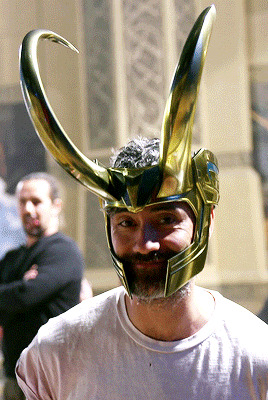
Waititi, Yost, Pearson and Kyle did great work to cut through Loki’s illusions, both with dialogue and the visual allegory of his projections being dispelled by handy thrown objects, culminating in the very sweet ‘I’m here,’ scene at the end of the film. Loki seems to be much more open and expressive at the end of that film, and it seems like a weight has lifted off his shoulders.
But while this new Loki (Loki 2.0? Loki’s Show’s Loki? Loki II? Lokii? Lokii.) is shown a clip show of Ragnarok (one I previously theorized will be deliberately incomplete), that’s quite different from actually experiencing it, and he’ll be as performative as he was in Avengers and Thor 2. Instead of processing that ‘lack of presence’ as he did in Ragnarok, which came about as a result of Thor finally seeing through Loki’s illusions (guess he doesn’t fall for it anymore) as a result of their long history together, I suspect the band-aid will be torn off much more harshly by a total stranger who nonetheless simply sees through him.
Loki in general has a bad relationship with the truth (see the famous Vault Confrontation scene), and literally putting him on trial before the Truth Herself would certainly be enough to get him to switch from this phony expression:

To this one:

That’s not much of a facade there.
It’s not the same character arc as Ragnarok, but it does get us to a similar place, albeit in a darker and less healing way for Loki. I mean Lokii.
Anyhow. That’s what I got out of this thing.
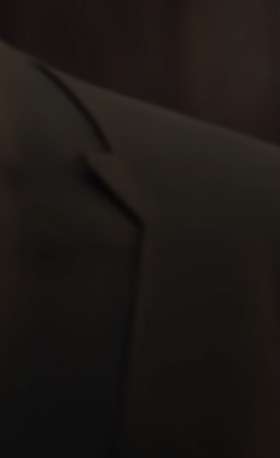
#tva#loki#mobius#mobius m mobius#mobius strip#THE COLLAR#trailer#anaylsis#theory#loki trailer theory#justice truth#verity willis#loki trailer#loki trailer analysis#lokii
61 notes
·
View notes
Note
Now that She Ra is over, what are your thoughts on it? What about that Catradora kiss?
Hi Anon! Thank you for the Ask!
ヽ(*⌒∇⌒*)ノ Where to start?
I have so many thoughts on the show, and I’ve had so many thoughts since season 1. I’ve not written much of anything about She-Ra because I keep coming back to this problem of ‘where to start,’ or how to structure my thoughts beyond a +1000 item list. I can’t even pick one or two thoughts to dive into, because they all end up connecting to everything else —> honestly, that’s the mark of a tight narrative, even the big pieces that can fully stand on their own are still leading through to another piece. I fail at every attempt to write something brief.
Section I: Short answer first.
I have a very short and subjective list of media where I not only love (for different reasons) nearly every character (main, secondary, background), but where I also feel that their individual places or moments or arcs concluded in a way that felt right from start to finish. It’s a short list of media where connections and conflict between characters never felt forced, out-of-place, out-of-context, or done for shock value. She-Ra and the Princesses of Power makes that very short and subjective list.
It’s not often that a story hits all the right notes with me, and it’s much more often that a story starts off strong like that, and then turns me off ½-⅔ of the way through. I’ve quit video games during the final boss fight because the story lost me in the lead-up and I wasn’t going to waste 10-20 minutes of my time for something that turned out to be ‘meh’. It ain’t got to be deep, or anything either.
I really loved the voice acting. Everyone is great. A post for another time.
I love the aesthetics, which I wasn’t sure of at first teasers, but won me over in less than 3 minutes of the first episode (season 1) because I love bright pastels, the character designs are fun (can I still gush over variety of body types? YES), so many opportunities to explore stylish takes on the characters, and those Moebius-inspired scenery/background designs are a special interest delight. Season 5 delivered a visual ‘end game’ for the aesthetics in many ways, Section III further down will get into that a bit.
Section II: “What about that Catradora kiss?”
I gotta preface this with, shipping is not my go-to for how I enjoy creative works. It’s not a hobby for me. Sure there’s a few I dig more than others, but I’m otherwise agnostic about ships, unless there is a really bad story-fit (and that’s usually a subjective thing), or involves tropes that are a deal-breaker for me (and those typically relate a lot to the story fit).
With that said, I’m really happy to see Catradora be pulled off so brilliantly, and I think the kiss is a bold and beautiful big deal in a way that might not be obvious when considered in a vacuum. I see it as passionate and heart-felt, but also, it’s achieving(?) a relatable outcome (for me at least) that’s hard to describe. It’s an outcome yielded by a story in which two women—a hero and a villain—are divided and fight bitterly and then reconcile through love, while fighting a purity cult whose founder-prophet-god-king forces subservience through a conversion designed to strip someone of their identity (e.g. names they’ve chosen for themselves), memories-and-motivations, and love for others.
Despite these conversions, love still remains, it can’t just be baptized or therapy-ed away. Controlling puritans and authoritarians wielding religion or peace-panaceas as a weapon have been the villains in the lives of countless women and LGBTQIA people for a very long time. So yeah, I’ve got some feels about that. The last time I felt anything similarly relatable, or as strongly, was the Utena and Anthy relationship in Revolutionary Girl Utena (and really, their kiss during the surreal sequence at the end of the film adaptation).
Section III: Thoughts on Cult Aesthetics and Clones (the rough cut)
(1) In the future scenes at the end, Adora’s white dress with gold tiara and accents have this kind of goddess-like or Pallas Athena feel to it, which is a great mirror of the design choices for the god-like Horde Prime, his Purity Space Cult, mechanics/ship, and flagship interior scenery. Not saying that was the intention, but that’s how it came across to me.
Of course, those colors would be used because She-Ra already wears white and gold with a bit of red accent, which complement how the princesses are bright and colorful (pastels and jewel tones). The bold and bright colors helps signify that Etheria is full of life. Etheria is verdant and magical, and that sets up a contrast to the Fright Zone and the darker colors found in Horde characters (Hordak, Shadow Weaver, Scorpia, Catra, Entrapta, etc).
So the first kind of contrast was with the Fright Zone standing out as a poisoned/toxic against the bright, lively colors of Etheria and the princesses. Season 5 introduces another take on that contrast as Horde Prime is the opposite, or antithesis of Etheria’s colorful life. He’s like anti-life with his shades of light-and-dark grays on white, and only glow-green as an accent. In some cultures and religious traditions, white is associated with purity, and in others it is associated with death.
When Horde Prime ‘purifies’ Hordak for the sins of individuality and emotion (emotion for others, for his own sake), Hordak is drained of the colors he chose for himself during exile. In addition to being a contrast to Horde Prime (and informed by the 80s cartoon design), Hordak’s dark blue (or blue-black) and red color palette reflects the traditional use of red as a color for evil (especially vampirism) from back when diabolism was a stand-in for ‘the Devil’ in many forms of visual media (comics, live-action, animation, etc). In place of diabolic red, Horde Prime has toxic glow-green.
I absolutely love the use of the glow-green accents. Color trends for villains and significations of evil come and go, and I’m glad to see the color green be used again, and used so well. The last time I saw that shade of glow-green used so well was in Sleeping Beauty (re: Maleficent’s magic and the orb on her staff) and as the Loc-Nar in Heavy Metal. In both films, there are connotations of evil as a poisonous and corrupting influence. Green, in the context of evil, almost always signifies poison (and sometimes envy). I also like that the glow-green color is used in ways that aren’t immediately saying ‘this is evil’, such as the green baptismal waters and flames from the purification scene, or the green amniotic protein fluid. The language of piety and trappings of the sacred can cloak a sinister purpose.
I don’t know if any of that was intentional, but Horde Prime feels like the perfect synergy of purity and death (which has additional connotations, but that’s a very personal interpretation).
(2) Horde Prime immediately gave me subtle cult vibes in his first cameo (Season 3), and the follow-through on that was perfect and exactly what I was hoping to see. The background music throughout the scenes aboard the flagship fits well (love the soundtrack), and has the quality of Ecstatic Experience without pulling directly from any specific religion. Horde Prime’s dialogue is a delightful bit of narcissism veiled with the language of piety.
A purity cult comprised of clone-brother-worshippers of the cult’s founder-prophet-god-king reinforces that narcissism and has all the fun-dark feels of shiny-techno-future-dystopias. It is also an interesting use of clones, especially in a story format that usually never has the time to really dive into the complexities of cloning. This is the sort of thing that you’d be more likely to see in a one-off episode of Star Trek: The Next Generation, rather than the basis for a greater scope villain, or multi-season nemesis. (and yes, Star Trek: TNG had an interesting clone episode)
Clones in science-fiction tend to fall into just a few tropes, and I generally dislike seeing clones show up in a story because the execution nearly always feels sloppy (in small ways or big ways). I did not get that feeling from She-Ra, where, the clones occupy the “cog in the machine” trope, but it is not their existence as clones that make them that way, it is the Will of Horde Prime that does. They are simultaneously expendable and sacred in their unity. It’s a nice flip on “stronger by working together” that Adora and the others have to learn (and struggle) to do.
It seems like, despite their religious programming, the clones have a little bit of their own personalities until Horde Prime ‘inhabits’ them to exert his Will. I’m trying not to read too much into it, b/c what comes across as ‘inhabits’ to me (especially with the religious/cult context), was probably meant more literal like described in the dialogue as a hive-mind control kind of thing. The first time it happens—to post-wipe/death Hordak—felt to me like a possession scene from The Exorcist, but without the kind of horror visuals that would scare both adults and children. The quick-and-subtle amount of body contortion and sound is still gross and creepy (because it should be), but it also reminds me of Ecstatic Experience in the form of speaking in tongues, or snake handling, or being a medium for a spirit. Again, I’m not saying any of that is intentional, but that’s how I see it.
(3) Finally, there is Entrapta, Hordak, and Wrong Hordak. Clones rarely get to be ‘humanized’ through friendship or romance arcs. I can think of a dozen or more robots that get to be humanized in that way, but can’t recall any clones that have (excluding doomed clones whose friendship/romance only existed for the sake of selling the tragedy of their death). Hordak gets death, renewal, and romance in a way that worked really well, and the totality of it is unique. I was a bit surprised that they could work in another clone—and I love Wrong Hordak—who pulls triple-duty as (1) comedy; (2) relevant to moving various pieces of the story along; and (3) more humanizing of the clones, which, again rarely happens as most stories take the easy low road when it comes to clones.
For Entrapta’s part, she’s never put in the position of giving up who she is (‘weird’ by many standards) for a romance. Her passion for technology is both an amusing double entendre at times, and integral to who she is. A romance for Entrapta does not replace her passion for technology, she can have both. Dating myself but, I came up in a time where most media (for children or adults) would rob a woman of her agency or passions during the resolution of a romance arc. Maybe times have changed, but it’s still nice to see none of that nonsense happening here.
31 notes
·
View notes
Photo
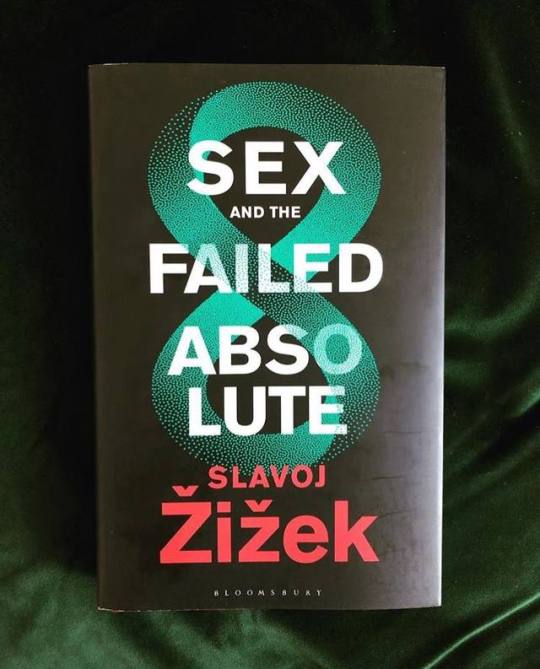
📗 Slavoj Žižek: Sex and the Failed Absolute - https://bit.ly/2m9vAA3 - free delivery worldwide
In the most rigorous articulation of his philosophical system to date, Slavoj Žižek provides nothing short of a new definition of dialectical materialism.
In forging this new materialism, Žižek critiques and challenges not only the work of Alain Badiou, Robert Brandom, Joan Copjec, Quentin Meillassoux, and Julia Kristeva (to name but a few), but everything from popular science and quantum mechanics to sexual difference and analytic philosophy. Alongside striking images of the Möbius strip, the cross-cap, and the Klein bottle, Žižek brings alive the Hegelian triad of being-essence-notion. Radical new readings of Hegel, and Kant, sit side by side with characteristically lively commentaries on film, politics, and culture.
Here is Žižek at his interrogative best.
📗 Slavoj Žižek: Sex and the Failed Absolute - https://bit.ly/2m9vAA3 - free delivery worldwide
NTRODUCTION: THE UNORIENTABLE SURFACE OF DIALECTICAL MATERIALISM
THEOREM I: THE PARALLAX OF ONTOLOGY Modalities of the Absolute-Reality and Its Transcendental Supplement – Varieties of the Transcendental in Western Marxism - The Margin of Radical Uncertainty
COROLLARY 1: INTELLECTUAL INTUITION AND INTELLECTUS ARCHETYPUS: REFLEXIVITY IN KANT AND HEGEL Intellectual Intuition from Kant to Hegel-From Intellectus Ectypus to Intellectus Archetypus
SCHOLIUM 1.1: BUDDHA, KANT, HUSSERL SCHOLIUM 1.2: HEGEL'S PARALLAX SCHOLIUM 1.3: THE “DEATH OF TRUTH”
THEOREM II: SEX AS OUR BRUSH WITH THE ABSOLUTE Antinomies of Pure Sexuation-Sexual Parallax and Knowledge-The Sexed Subject - Plants, Animals, Humans, Posthumans
COROLLARY 2: SINUOSITIES OF SEXUALIZED TIME Days of the Living Dead – Cracks in Circular Time
SCHOLIUM 2.1: SCHEMATISM IN KANT, HEGEL… AND SEX SCHOLIUM 2.2: MARX, BRECHT, AND SEXUAL CONTRACTS SCHOLIUM 2.3: THE HEGELIAN REPETITION SCHOLIUM 2.4: SEVEN DEADLY SINS
THEOREM III: THE THREE UNORIENTABLES Möbius Strip, or, the Convolutions of Concrete Universality-The “Inner Eight”-(((Suture Redoubled)))-Cross-Capping Class Struggle-From Cross-Cap to Klein Bottle-A Snout in Plato's Cave
COROLLARY 3: THE RETARDED GOD OF QUANTUM ONTOLOGY The Implications of Quantum Gravity-The Two Vacuums: From Less than Nothing to Nothing – Is the Collapse of a Quantum Wave Like a Throw of Dice?
SCHOLIUM 3.1: THE ETHICAL MOEBIUS STRIP SCHOLIUM 3.2: THE DARK TOWER OF SUTURE SCHOLIUM 3.3: SUTURE AND HEGEMONY SCHOLIUM 3.4: THE WORLD WITH(OUT) A SNOUT SCHOLIUM 3.5: TOWARDS A QUANTUM PLATONISM
THEOREM IV: THE PERSISTENCE OF ABSTRACTION Madness, Sex, War- How to Do Words with Things-The Inhuman View – The All-Too-Close In-Itself
COROLLARY 4: IBI RHODUS IBI SALTUS! The Protestant Freedom-Jumping Here and Jumping There-Four Ethical Gestures
SCHOLIUM 4.1: LANGUAGE, LALANGUE SCHOLIUM 4.2 - PROKOFIEV'S TRAVELS SCHOLIUM 4.3: BECKETT AS THE WRITER OF ABSTRACTION
📗 Slavoj Žižek: Sex and the Failed Absolute - https://bit.ly/2m9vAA3 - free delivery worldwide
5 notes
·
View notes
Text
Moebius strip's ants
Animación basada en la obra “Möbius Strip II”, de M.C. Escher. Crédito: romullus3d
0 notes
Text
USA/SPAIN: Tony Levin on MoonJune's new release of Xavi Reija "The Sound Of The Earth" with Markus Reuter & Dusan Jevtovic
MoonJune announces new release
of the Catalan drummer extraordinaire
XAVI REIJA
"The Sound Of The Earth"
XAVI REIJA drums
TONY LEVIN bass guitar, upright bas, stick
DUSAN JEVTOVIC guitar
MARKUS REUTER touch guitar
CD • $15 +shipping
HD Download • $10
Click on any image or link above to fully stream the album.
The Sound Of The Earth Notes by Dan Burke First heard on Xavi and Dusan’s inspired 2014 album, “Random Abstract” by XaDu, “Deep Ocean” starts things off with a fanfare of muscular guitar and cymbals crashing like waves on the rocky coast, carving out the beach and unearthing a primal groove with growling bass and jittering spectral figures. “The Sound of the Earth I” brings to mind David Sylvian’s post-Japan near ambient instrumental excursions where space and pause became as integral to the “composition as place” as his trusty Prophet 5. Once this world is created, and with a decidedly Beckian vibe (Jeff, that is), Dusan wrings from the neck of his guitar, some of the most emotive broken phrases and edited soulful voicings. “From Darkness” finds Tony’s minimalist bass pulse in 5/8 with snare/kick serving as the groundwork for Dusan and Markus’ spiraling moebius strip guitar riffery. There is a slightly frenzied insistence to this track which serves as a great counterpoint to the more atmospheric work. Leading off with playful skipping brushwork and a rich and supple Levin bass groove, then painted with Reuter’s ominous stained and weathered guitar tones, “The Sound of the Earth II” is a dark canvas of shifting clouds of color. Dusan’s skittery clipped chords and abbreviated lead lines bring necessary tension for the fluid guitar phrasings which seem to erupt and then run down the face of this 12 minute tone painting. “Serenity” is an inspired atmospheric piece which features an abstracted melodic lead buoyed by an insistent tamboura-like repeated wavering note. There is enough creativity and inspiration in this one track to feed a whole album’s worth of music. Beginning with a deep space Curtis Mayfield vibe, “The Sound of the Earth III” unfolds slowly with a practiced teasing restraint that allows the music to bloom naturally. “Lovely Place” finds the notes of Dusan’s guitar projected, like light, into a prism and coming back as a myriad of shimmering colors. Reuter’s stellar fluid guitar solo has a heroic and almost “Hotel California” build and break before returning to Dusan’s delicate finger work. At nearly 17 minutes long, “The Sound of the Earth IV” would feel right at home on side 3 of a double Kosmiche Musik LP from 1969. This is heady stuff with lots of room for some really spirited interplay. Markus inspires this kind of creativity with his willingness to step way outside of the comfort zone. The musicians feel as though they’ve played together for years. In “Take a Walk” Dusan knits a lean triplet argeggiated guitar riff into a tight braid to give structure while a swaggering monster groove builds and builds, all the while tugging mercilessly at the yarn of his guitar until it temporarily unravels into a series of more tentative notes and slightly bent chords. You can feel the room in this recording and, by that, I mean you can sense both the physical space and the emotional space between these four gifted players. There is a level of trust and comfort here that puts the listener at ease and ready to take the ride. Band leader and Catalan drummer, Xavi Reija and Serbian-born guitarist Dusan Jevtovic have worked together on numerous projects these past few years and have become an intuitive musical unit. Born in Boston, Tony Levin, with his impeccable pedigree from Herbie Mann and Chuck Mangione to Peter Gabriel and King Crimson as well as his own 10- year ongoing project Stick Men, along with fellow Stick Men, Crimson ProjeKCt and Centrozoon member German-born Markus Reuter, have likewise developed a common language communicating through music. Such heartfelt and enthusiastic playing is in short supply these days. This is not music pigeon-holed for easy consumption, rather, it challenges and rewards more and more with each listening. So put down your phone, lower the lights and prepare to experience the gift of this inspired recording.
"The Sound Of The Earth is like a musical buffet, with something for everyone who has a taste for genre-crossing electric music. The Reija/Jevtovic pairing has a history to draw from, as does the Levin/Reuter axis—and the combination uncovers a real chemistry. Yet another magical MoonJune session." - Mark Sullivan, All About Jazz
"The Sound Of The Earth" was recorded at Club House Studio, Rhineback, NY, USA by Paul Antonell in August 2016. Mixed by Jesus Rovira at La Casa Murada Studio, Banyeres del Penedés, Catalonia, Spain in 2018. Mastered by Álvaro Balañá at Impact Mastering Lab, Barcelona, Catalonia, Spain. Produced by Xavi Reija. Executive producers Leonardo Pavkovic and Xavi Reija.
via Blogger https://ift.tt/2LElMFd
0 notes
Text

source: bishopsbox
Moebius strip II (1963), woodcut in red, black and gray-green, printed from three blocks
by: M.C. Escher
5 notes
·
View notes
Link
Cave to Canvas, Moebius Strip II (Red Ants) - MC Escher, 1963 ...more Escher...I know you want it....wdk
0 notes
Photo

Moebius Strip II (Red Ants) - MC Escher, 1963
279 notes
·
View notes
Photo

Moebius Strip II, 1964, M.C. Escher
264 notes
·
View notes

